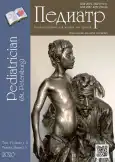Surgical complications of peritoneal dialysis in children with acute kidney failure
- 作者: Dobroserdov D.A.1,2, Shchebenkov M.V.1,2, Shavkin A.L.3
-
隶属关系:
- North-Western State Medical University named after I.I. Mechnikov
- Saint Petersburg Children’s Hospital No.
- Saint Petersburg Children’s Hospital No. 1
- 期: 卷 11, 编号 3 (2020)
- 页面: 57-63
- 栏目: Original studies
- URL: https://journals.rcsi.science/pediatr/article/view/42502
- DOI: https://doi.org/10.17816/PED11357-63
- ID: 42502
如何引用文章
详细
The dialysis department of the Children’s City Multidisciplinary Clinical Specialized Center for High Medical Technologies has been operating since 1977 and is the only specialized department in the North-West Region of the Russian Federation that provides assistance to children with both acute and chronic renal failure. Peritoneal dialysis is the treatment of choice for children with acute renal failure, the most common cause of which is hemolytic-uremic syndrome. Despite widely used measures to improve the results of peritoneal dialysis, complications are extremely common. The article analyzes the complications of peritoneal dialysis in children with acute renal failure who were treated in a hospital from 2008 to 2018. The emphasis in the study is on the analysis of complications of peritoneal dialysis, in the treatment of which the surgeon actively participated or should have taken part in. If the problem of acute renal failure is multidisciplinary in the sense that it requires the participation of nephrologists, resuscitators, infectious disease specialists, then if necessary, renal replacement therapy requires the surgeon to become not only a specialist providing “access”, but also a full-fledged participant in the treatment process. As follows from the foregoing, the surgeon’s actions depend not only on the quality of dialysis, but also the timeliness and adequacy of treatment of complications, which ultimately improves or worsens the quality of medical care in general.
作者简介
Dmitrii Dobroserdov
North-Western State Medical University named after I.I. Mechnikov; Saint Petersburg Children’s Hospital No.
编辑信件的主要联系方式.
Email: dimit@bk.ru
Assistant Professor Department of Pediatric Surgery
俄罗斯联邦, Saint PetersburgMikhail Shchebenkov
North-Western State Medical University named after I.I. Mechnikov; Saint Petersburg Children’s Hospital No.
Email: shebenkovmihail@gmail.com
MD, PhD, Dr. Med. Sci. Professor Department of Pediatric Surgery
俄罗斯联邦, Saint PetersburgAlexey Shavkin
Saint Petersburg Children’s Hospital No. 1
Email: dialys.dgb@gmail.com
Associate Professor, Head Dialysis Department
俄罗斯联邦, Saint Petersburg参考
- Бикбов Б.Т., Томилина Н.А. Заместительная терапия терминальной хронической почечной недостаточности в Российской Федерации в 1998–2013 гг. Отчет по данным российского регистра заместительной почечной терапии. Часть 1 // Нефрология и диализ. – 2015. – Т. 17. – № S3. – С. 5–111. [Bikbov BT, Tomilina NA. Renal replacement therapy for ESRD in Russian Federation, 1998–2013 Report of the Russian Renal Replacement Therapy Registry. Part 1. Nephrology and dialysis. 2015;17(S3):5-111. (In Russ.)]
- Руководство по диализу / под. ред. Д.Т. Даугирдаса, П.Дж. Блейка, Т.С. Инга. Москва: Центр диализа, 2003. – 744 c. [Handbook of dialysis. Ed. by J.T. Daugirdas, P.G. Blake, T.S. Ing. Moscow: Tsentr dializa; 2003. 744 p. (In Russ.)]
- Ермоленко В.М., Николаев А.Ю. Острая почечная недостаточность. – М.: ГЭОТАР-Медиа, 2010. – 240 c. [Ermolenko VM, Nikolaev AYu. Ostraya pochechnaya nedostatochnost’. Moscow: GEOTAR-Media; 2010. 240 p. (In Russ.)]
- Мухина Ю.Г. Нефрология детского возраста. – М.: МЕДПРАКТИКА-М, 2010. – 736 c. [Mukhina YuG. Nefrologiya detskogo vozrasta. Moscow: MEDPRAKTIKA-M; 2010. 736 p. (In Russ.)]
- Bonilla-Felix M. Peritoneal dialysis in the pediatric intensive care unit setting: techniques, quantitations and outcomes. Blood Purif. 2013;35(1-3):77-80. https://doi.org/10.1159/000345186.
- Crompton CH, Balfe JW, Khoury A. Peritoneal dialysis in the prune belly syndrome. Perit Dial Int. 1994;14(1):17-21.
- Dufek S, Holtta T, Fischbach M, et al. Pleuro-peritoneal or pericardio-peritoneal leak in children on chronic peritoneal dialysis-A survey from the European Paediatric Dialysis Working Group. Pediatr Nephrol. 2015;30(11):2021-2027. https://doi.org/10.1007/s00467-015-3137-z.
- Fraser N, Hussain FK, Connell R, Shenoy MU. Chronic peritoneal dialysis in children. Int J Nephrol Renovasc Dis. 2015;8:125-137. https://doi.org/10.2147/IJNRD.S82419.
- Grylack L, Medani C, Hultzen C, et al. Nonoliguric acute renal failure in the newborn: a prospective evaluation of diagnostic indexes. Am J Dis Child. 1982;136(6):518-520. https://doi.org/10.1001/archpedi.1982.03970420042008.
- Kim JE, Park SJ, Oh JY, et al. Noninfectious Complications of Peritoneal Dialysis in Korean Children: A 26-Year Single-Center Study. Yonsei Med J. 2015;56(5):1359-1364. https://doi.org/10.3349/ymj.2015.56.5.1359.
- Saha TC, Singh H. Noninfectious complications of peritoneal dialysis. South Med J. 2007;100(1): 54-58. https://doi.org/10.1097/01.smj.0000253477. 82103.a6.
- Weaver DJ, Jr., Somers MJG, Martz K, Mitsnefes MM. Clinical outcomes and survival in pediatric patients initiating chronic dialysis: a report of the NAPRTCS registry. Pediatr Nephrol. 2017;32(12):2319-2330. https://doi.org/10.1007/s00467-017-3759-4.
补充文件








